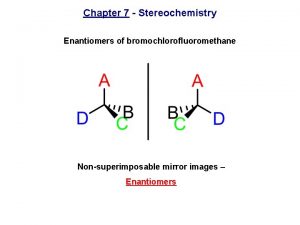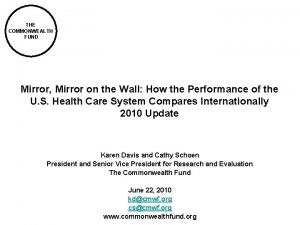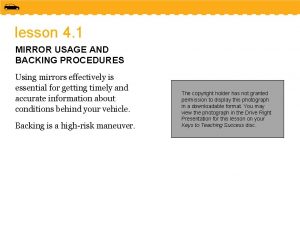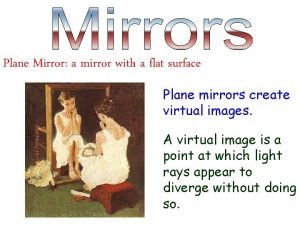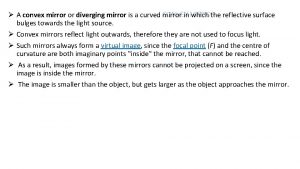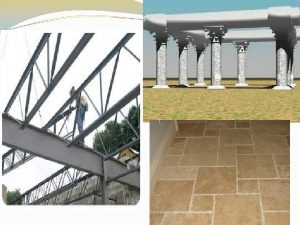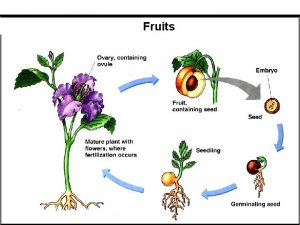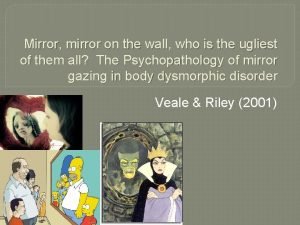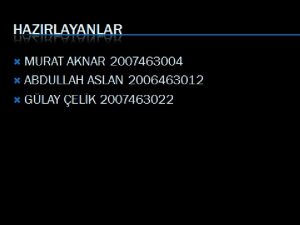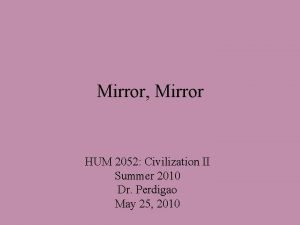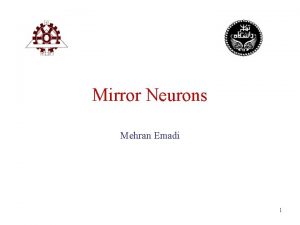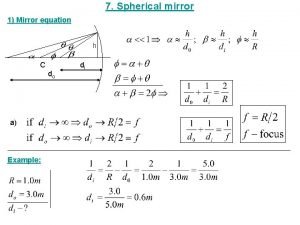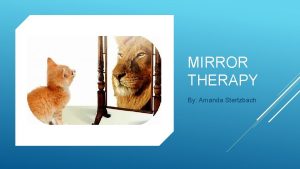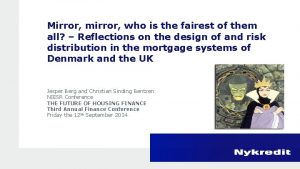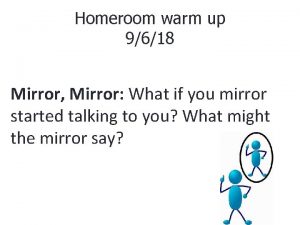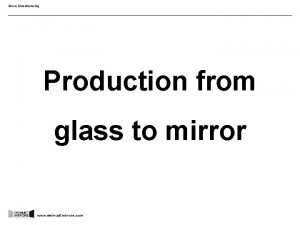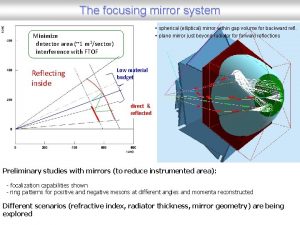Mirror mirror on the wall who is the




























- Slides: 28

Mirror, mirror on the wall, who is the ugliest of them all? The Psychopathology of mirror gazing in body dysmorphic disorder Veale & Riley (2001)

I. Background A. DSM-IV Criteria for Diagnosis (time of study) 1. Preoccupation with an imagined defect and/or if a slight flaw is present, it is exaggerated. 2. Preoccupation will cause clinically significant distress or impairment in social, occupational, or other everyday functioning 3. Hidden disorder: often first diagnosed as OCD or depression or social phobia 4. However, BDD is not accounted for by another disorder (OCD, depression, anorexia, etc…) or medical condition

I. Background B. Common Characteristics of BDD 1. Mirror gazing appears in about 80% of BDD patients, the other 20% avoid mirrors 2. Often times mimics depression or social phobia until they are asked 3. Shamed about behavior and disgust of appearance

I. Background C. Many diagnosed will look in the mirror because they: • Are driven by hopes they will look different • Show a desire to know exactly how they look • Believe that they will feel worse if they do not look • Focus on internal feelings, not external presentation • Practice putting on “public face” to mask their issues

II. Aim of the Study A. Aims of the Study • 1. To have a better understanding of the psychopathology of mirror gazing in order to best formulate new strategies for therapy • 2. To generate hypotheses for future experimental studies in order to develop a cognitive behavioural model of BDD

III. Methodology � A. Type of study • 1. Pilot study • 2. Apparatus: Questionnaire • 3. Data: quantitative � B. Sample • 1. 52 patients with BDD who reported mirror gazing • 2. 55 controls recruited from personal contacts of V&R 3. The 2 groups were matched for age & sex a. Mean age= BDD 30. 1 vs Control 33. 4 b. Gender= Both groups have slightly more females

III. Methodology C. A different pilot study showed 2 types of mirror gazing: • 1. Many patients and controls tended to have 1 session a day which is longer (like putting on makeup or shaving) • 2. Remainder of the mirror sessions consisted of shorter sessions during the day • 3. Controls were less likely to participate in long sessions • 4. Results of pilot study shown in Table 1

� A. Setup of Procedure IV. Procedure � 1. Ps were given self-report mirror gazing questionnaire � 2. Ps were to report the feelings they had while in front of a mirror during the past month � 3. Ps were first asked if they had a ‘long session’ in front of the mirror (like shaving or putting on makeup) a. If so, they were asked a series of questions about their actions and/or thoughts during a typical long session b. Ps then repeated same questioning about ‘short sessions’ 1. Example= checking appearance

“This presentation contains copyrighted material under the educational fair use exemption to the U. S. copyright law” Video 2 Veale & Riley (2000) AICE Psych- Individual Differences

IV. Procedure B. “Length of time mirror gazing” portion Ps were asked about: • 1. The average duration of a “long” session in minutes. • 2. The estimated maximum amount of time on any one occasion that he or she had spent in front of a mirror in hours/minutes • 3. The avg duration (in minutes) and the frequency of a short session in front of a mirror during the last month

IV. Procedure C. “Motivation before looking in a mirror” portion • (Statements shown in Table 2) 1. Subjects were given statements in which they had to rate how much they agree with that statement on a scale of 1 -5 (strongly disagree to strongly agree) • a. There was also space where they could fill in any additional reasons for looking in the mirror • b. Questions were repeated for short session as well

IV. Procedure D. “Focus of Attention” portion • 1. Subjects were asked what they focus on (physical and/or emotional) during both long and short sessions • 2. Subjects rated their experiences on a 9 point scale a. -4 meaning ‘I am entirely focused on my reflection’ b. +4 meaning ‘I am entirely focused on an impression or feeling that I get about myself’

IV. Procedure E. “Distress before & after looking in front of mirror” 1. Asked to rate degree of distress on 10 point scale 2. Asked at 3 different times to rate their distress a. before they looked in the mirror for a long session b. immediately after looking in the mirror c. after resisting the urge to look in a mirror 3. Same questions then applied to short sessions a. Ps only responded to 2 different times (before & immediately after)

IV. Procedure F. “Behavior in front of a mirror” portion 1. Subjects were asked what activities they did in front of the mirror for both long and short session 2. Asked to rate the percentage of time spent on 9 activities and it had to add up to 100% a. Such as “combing/styling hair” and “feeling the skin” 3. At the end, there was also a blank area for other behaviors to be written in

IV. Procedure (yes, still…) G. “Type of light preferred” portion • 1. Ps asked if the type of light was important a. Ranged from ‘natural day light’ to ‘artificial light’ H. “Types of reflective surfaces” portion • 1. Inquired into what Ps used to mirror gaze a. Such as just mirrors or what else (like cd) I. “Mirror avoidance” portion • Asked if they avoided certain types of mirrors & in which situations they did so

V. Results (general) A. Ps experiencing a “long session” each day • 1. 44/52 BDD Ps (84. 6%) vs. 16/54 control Ps (29. 6%) a. Average Time: BDD= 72. 5 mins vs. Control= 21. 3 mins b. BDD longest time=173. 8 mins vs. control longest time= 35. 5 mins B. Ps experiencing a “short session” each day • 1. 45/52 BDD Ps (86. 5%) vs. 43/54 control Ps (79. 6%) a. Average Time: BDD= 4. 8 mins vs. Control= 5. 5 mins b. Average Instances per day: BDD= 14. 6 vs. Control= 3. 9 *No significant differences were found for age and gender among Ps

V. Results C. “Motivation for looking in a mirror” results • 1. BDD Ps were more likely to endorse all the beliefs listed a. Also more likely to gaze when feeling depressed • 2. Control Ps were more interested in making themselves look presentable

V. Results D. “Behaviour in front of mirror” Results • 1. Long sessions: a. Same for BOTH groups in the activities of: applying makeup, styling hair, picking their spots, feeling skin with their fingers b. Controls more likely to: “removing hairs or shaving” c. BDD more likely to: “compare their image to one they had in their head” and “try to see something different” • 2. Short sessions: a. Controls more likely to: “shaving” b. BDD more likely to: “Checking make up, practicing best face, comparisons with image”

V. Results E. “Distress before, after, or resisting a check” Results • 1. BDD significantly more distressed than controls in LS & SS • 2. BDD more distressed after gazing & greater distress if they resisted the urge to gaze • 3. BDD reported more handicaps from mirror gazing a. Such as ‘being late to appointments’ or ‘causing traffic accidents’

V. Results F. “Focus of attention in mirror” • 1. For a long session: a. BDD more likely to focus on an internal impression/feeling b. BDD more likely to focus on specific parts of their appearance

V. Results G. “Type of Light” Results • 1. No sig. diff. for among BDD & controls for light preference (either natural day-light or artificial) H. “Types of Mirrors” Results • 1. For a long sessions: a. 22/42 BDD used a series of mirrors with different profiles compared to 1/15 Controls b. both BDD & controls used shop windows c. BDD used different reflective surfaces

“This presentation contains copyrighted material under the educational fair use exemption to the U. S. copyright law” Video 3 Veale & Riley (2000) AICE Psych- Individual Differences

VI. Discussion A. Overall Findings/Discussion • 1. BDD patients have an eternal hope that they will look different to their internal body image • 2. BDD patients are uncertain about their body image and demand to know exactly how they look. • 3. BDD patients believe they will feel worse if they resist gazing • 4. BDD patients are driven by a desire to camouflage their appearance or excessively groom to make themselves look their best or to feel “comfortable”

VI. Discussion B. How the study influenced BDD therapy • 1. Veale & Riley adapted therapeutic strategies to help BDD patients by monitoring: a. Longest mirror session time b. Frequency of short sessions in the mirror c. Discourage mirror avoidance

VI. Discussion C. Recommendations for BDD patients D. Practical Applications • 1. CB Model- ABC approach A- beliefs prior to mirror gazing B- behavior when looking in mirror C- consequence of looking in the mirror

VII. Strengths of the Study Strengths: • • • BDD Ps were diagnosed through DSM-IV criteria Age & gender matching of groups This was a pilot study that sets up a better true study Use of comparison group instead of only BDD Ps Quantitative data analysis Rather large group of BDD Ps given the topic

VIII. Weaknesses of the Study Weaknesses: • Validity of questionnaire data/self-report data • Recruitment of controls • Very limited qualitative data to support quantitative data

IX. Ethical Issues & Ecological Validity A. Ethics: • 1. May have induced stress completing questionnaire or even participating in the study itself • 2. Other ethical considerations are intact (RTW, etc. ) B. Ecological Validity: • 1. Most likely applied to BDD population a. but not general population • 2. Self-report data reliability questioned a. improve by viewing actual behavior • 3. Completion at home a plus
 Nonsuperposable
Nonsuperposable Mirror mirror commonwealth fund
Mirror mirror commonwealth fund The rearview mirror should be checked
The rearview mirror should be checked It is a mirror with flat surface
It is a mirror with flat surface Convex mirror is a diverging mirror
Convex mirror is a diverging mirror T junction english bond
T junction english bond Members used to carry wall loads over wall openings
Members used to carry wall loads over wall openings Sound walls vs word walls
Sound walls vs word walls Fruit develops from ovary
Fruit develops from ovary Chris brown wall to wall
Chris brown wall to wall Cái miệng bé xinh thế chỉ nói điều hay thôi
Cái miệng bé xinh thế chỉ nói điều hay thôi Hình ảnh bộ gõ cơ thể búng tay
Hình ảnh bộ gõ cơ thể búng tay đặc điểm cơ thể của người tối cổ
đặc điểm cơ thể của người tối cổ Cách giải mật thư tọa độ
Cách giải mật thư tọa độ Tư thế worm breton
Tư thế worm breton Tư thế ngồi viết
Tư thế ngồi viết ưu thế lai là gì
ưu thế lai là gì Voi kéo gỗ như thế nào
Voi kéo gỗ như thế nào Thẻ vin
Thẻ vin Thể thơ truyền thống
Thể thơ truyền thống Các châu lục và đại dương trên thế giới
Các châu lục và đại dương trên thế giới Từ ngữ thể hiện lòng nhân hậu
Từ ngữ thể hiện lòng nhân hậu Diễn thế sinh thái là
Diễn thế sinh thái là V. c c
V. c c Slidetodoc
Slidetodoc Làm thế nào để 102-1=99
Làm thế nào để 102-1=99 Bài hát chúa yêu trần thế alleluia
Bài hát chúa yêu trần thế alleluia Lời thề hippocrates
Lời thề hippocrates Hươu thường đẻ mỗi lứa mấy con
Hươu thường đẻ mỗi lứa mấy con
